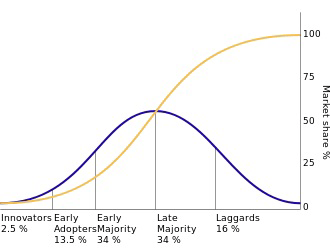Editor’s Note: The Inside Track is a recurring column designed exclusively for our Just Business email newsletter. Authors of these columns aim to provide you with their own perspective on a current trend or development within their industry, getting you on The Inside Track.
 A seasoned rancher was feeling forced to try a new innovation against his will.
A seasoned rancher was feeling forced to try a new innovation against his will.
“I’ve seen a lot of changes in my life,” he wryly replied. “Hated every darn one of them.”
Certainly, there are many people who feel just like the rancher, fighting change and delaying innovation for as long as possible. At the other end of the spectrum are those who spare no expense to try something new.
By the fall of 2012, some 13,000 people reportedly made at least a $5,000 deposit for the privilege of someday owning an $80,000 Tesla S electric sports sedan, which relies upon the installation of recharging stations every few hundred miles.
The pattern of how our society adjusts to an innovation was first presented in scholarly literature by Everett Rogers, an Iowa farm boy who became an expert in communications theory. His pioneering work known as Diffusion of Innovations was based upon how Depression Era farmers adopted higher-yielding hybrid seed corn varieties and is a staple in marketing and business education classrooms.
The Diffusion of Innovation concept was modernized for the Technology Age by Silicon Valley guru Geoffrey Moore’s book, “Crossing the Chasm.”
When placed into a graph, the acceptance of an innovation looks like an S Curve.

Five segments
At its heart, the Diffusion of Innovations describes how innovations spread through a culture through a series of population groups, each with their own rationale for adopting a new innovation. Through more than 1,500 studies, five distinct groups are observed as an innovation is spread. The first three reflect desire to adopt, and the last two a desire to resist.
A quick snapshot of the five segments:
Innovators – Often viewed as risk-lovers and technology nerds, they thrive on trying anything new and will pay a premium for it. If you camped out for an iPhone 5, you qualify.
Early adopters – These learned individuals are highly revered as wise opinion leaders in their community. Their experience often shapes ultimate success and adoption rates.
Early majority – More pragmatic and bound by tradition, these people will observe the success of opinion leaders before they take the plunge.
Late majority – Generally resistant to change, these people will remain satisfied with their current solution until they experience the pain of not converting.
Laggards – With an extreme resistance to innovation, these individuals consider change as evil. They won’t convert until all other options vanish.
Where are you?
Every business should give consideration to the stage of their products or services on the S curve of innovation adoption. It helps if you believe everything has a lifecycle and that your business might be a burning platform that could easily vanish in a fast-changing marketplace.
Companies with new offerings know they only need a small sliver of the market to fall in love with their product or service. They can focus on engaging risk-takers and smart opinion leaders.
Those with products or services in the early majority stage know their offering has plenty of room to grow. Nevertheless, it is not too early to be considering investments into differentiation or innovations.
Those with a late majority offering recognize their path is toward eventual obsolescence, either through commoditization by being replaced by other innovations. It might be time to slash expenses or shift into something else.
When reflecting on the diffusion of innovation, keep in mind the wisdom of business guru Peter Drucker, who asserted 60 years ago that business has just two basic functions – marketing and innovation. These two functions produce results while all other functions are costs.
Ask yourself if marketing and innovation are treated with the priority implied by Drucker’s perspective, and if not, what needs to change before it’s too late. It would be a great topic for your next executive planning meeting.
As the innovative scientist, statesman and accidental electrician Benjamin Franklin often advised, “By failing to prepare, you are preparing to fail.”
Ron Arp is president of the Brush Prairie-based communication firm Amplify Group Inc., which helps companies introduce and market innovations.
{jathumbnail off}



